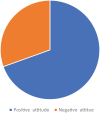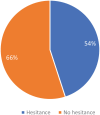Parents' hesitance to vaccinate their daughters with the human papillomavirus vaccine and its associated factors in Northwest Ethiopia
- PMID: 40351827
- PMCID: PMC12064895
- DOI: 10.1177/25151355251337622
Parents' hesitance to vaccinate their daughters with the human papillomavirus vaccine and its associated factors in Northwest Ethiopia
Abstract
Background: Human papillomaviruses are the most common sexually transmitted infections, and persistent infection can lead to cervical cancer. In line with WHO recommendations to prevent cervical cancer, human papillomavirus vaccination is considered mandatory. Despite various challenges influencing decision-making for HPV vaccination, including HPV vaccine hesitancy, efforts are made to promote its uptake.
Methods: A community-based cross-sectional study was conducted from March 1 to April 30 among 400 parents of adolescents. A simple random sampling technique was used to select study participants. A structured questionnaire was employed for data collection, and the data were gathered through interviews. Subsequently, the data were entered into EPI data 3.1 statistical software and analyzed using SPSS version 25. The association between variables was analyzed using bivariate and multivariable logistic regression models, and a p-value <0.05 at 95% confidence interval was considered statistically significant.
Results: A total of 400 participants were included with a response rate of 99.3%. The prevalence of HPV vaccine hesitancy among parents of daughters was 54%. Multivariable logistic regression showed that educational status (Adjusted Odds Ratio (AOR) = 0.8, 95% CI: (0.69-0.93)), effectiveness of HPV vaccine (AOR = 1.9, 95% CI: (1.14-3.17)), knowledge (AOR = 0.5, 95% CI: (0.13-0.75)), and obtained information (AOR = 3.1, 95% CI: (2.24-4.29)) were significantly associated with human papillomavirus vaccine hesitancy.
Conclusion: This study demonstrates that parents' hesitance to vaccinate their daughters with the human papillomavirus vaccine was high. Parents' hesitance to vaccinate their daughters with the human papillomavirus vaccine was strongly associated with the effectiveness of the HPV vaccine, obtained information about the HPV vaccine, knowledge, and educational status.
Keywords: Dangila; HPV vaccine hesitance; parents of adolescent.
Plain language summary
Parents’ hesitance to vaccinate their daughters with the human papillomavirus vaccine This study demonstrates that parents’ hesitance to vaccinate their daughters with the Human Papillomavirus (HPV) vaccine was high. Parents’ hesitance to vaccinate their daughters with the HPV vaccine was strongly associated with the effectiveness of the HPV vaccine, obtained information about the HPV vaccine, knowledge, and educational status.
© The Author(s), 2025.
Figures


Similar articles
-
Parents' willingness to vaccinate their daughters with human papillomavirus vaccine and associated factors in Debretabor town, Northwest Ethiopia: A community-based cross-sectional study.Hum Vaccin Immunother. 2023 Dec 31;19(1):2176082. doi: 10.1080/21645515.2023.2176082. Epub 2023 Feb 15. Hum Vaccin Immunother. 2023. PMID: 36794293 Free PMC article.
-
Knowledge and willingness of parents towards child girl HPV vaccination in Debre Tabor Town, Ethiopia: a community-based cross-sectional study.Reprod Health. 2022 Jun 10;19(1):136. doi: 10.1186/s12978-022-01444-4. Reprod Health. 2022. PMID: 35689288 Free PMC article.
-
Parents' Intentions of Human Papillomavirus Vaccination for Students in Vietnam: A Cross-Sectional Study.Cancer Control. 2024 Jan-Dec;31:10732748241284907. doi: 10.1177/10732748241284907. Cancer Control. 2024. PMID: 39270069 Free PMC article.
-
Willingness to vaccinate their daughters against human papillomavirus among parents of Ethiopian adolescent girls: a systematic review and meta-analysis.J Pharm Policy Pract. 2023 Oct 24;16(1):126. doi: 10.1186/s40545-023-00639-9. J Pharm Policy Pract. 2023. PMID: 37875991 Free PMC article. Review.
-
Acceptance of human papillomavirus vaccination and parents' willingness to vaccinate their adolescents in Ethiopia: a systematic review and meta-analysis.Infect Agent Cancer. 2023 Oct 11;18(1):59. doi: 10.1186/s13027-023-00535-6. Infect Agent Cancer. 2023. PMID: 37821992 Free PMC article. Review.
References
-
- WHO. Human Papillomavirus. WHO vaccine-preventable diseases surveillance standards. Geneva: WHO, 2018.
-
- Health EMO. Human papillomavirus and related diseases report. Version posted at wwwhpvcentrenet (2023).
-
- World Health Organization. Cervical Cancer, https://www.who.int/cancer/prevention/diagnosis-screening/cervical-cance... (2018, accessed 2021).
-
- WHO. Summary WHO SAGE conclusions and recommendations on vaccine hesitancy, http://wwweurowhoint/data/assets (2015).
-
- WHO. Report of the sage working group on vaccine hesitancy. Geneva: WHO, 2014.
LinkOut - more resources
Full Text Sources
Miscellaneous

